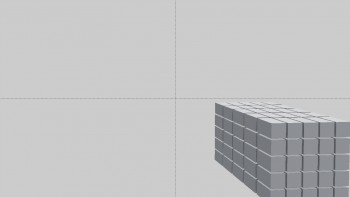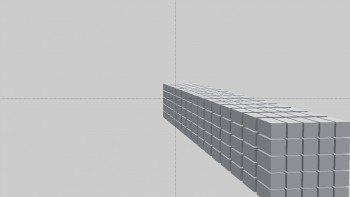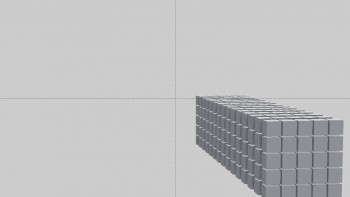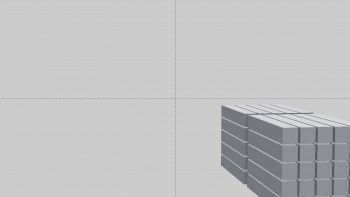The number of elements that make the object of weapon is set on us (after all we are reproducing a real model). Even though the shapes are imposed on us, it is still worth creating an interesting composition. The process of searching and matching detailed layers, with the rest can be started at the stage of creating a silhouette. Models of monotony structure look much less attractive. Solutions to similar designing problems could be found in, for example, nature or abstract paintings.
Autor: Pirat
3.6. Movable parts
Games treat weapon only as a prop therefore, there is no need to imitate the mechanism working inside the model. It saves the amount of tris and assets. What is more it shortens the time required to prepare a model. There are usually the following exceptions:
- the inside of the optical devices,
- a magazine,
- a lock,
- the inside of the break-open kinds of weapons,
- the inside of pistols – slides, barrel, parts exposed while shooting,
- elements visible while reloading, e.g. the inside of a grenade launcher.
Showing mechanical elements aims only at creating a feeling of playing with a „real” thing. A player needs to believe in the illusion created by a graphic. Therefore, each movable element visible by a camera should be somehow justified, have shape and composition. The relation between them should not rise any concern of an onlooker.
Not many players have in-depth knowledge about weapon or machines’ construction. But seeing different kinds of mechanisms every day, people have adjusted some patterns and schemes, and subconsciously compare them with pictures they see, e.g. in games. If what they see does not match the imagination / pattern, they will question the authenticity of the world of game. Badly designed mechanism will not mislead the viewer.
![Valve Corporation, Hidden Path Entertainment. <b>Counter-Strike: Global Offensive</b> [PC]. Valve Corporation, 2012, <i>source: http://images.akamai.steamusercontent.com/ugc/615041741048055148/81569A53AE4C339A123A41FA2ADC73FC662120C1/</i>](http://piratportfolio.com/fpp_eng/wp-content/uploads/2015/08/3.6.X-1024x553.jpg)
3.5. An object significant features
The object of a prop should indicate straightaway its purpose and function. A player after taking a prop should instantly know what it can be used for. He should be able to answer the following questions: How does it work? How can it be used? What kind of weapon is it?
Ambiguity is usually caused by complexity and not clear silhouette or failure to capture the object’s characteristic features. While preparing weapon for the FPP projection one should answer the following questions:
- What element tells us that an X object is perceived as an X object?
- Which elements of the X object tell us what it can be used for? Is it weapon, an element of a jigsaw or an ordinary object?
- Is player informed clearly what to expect after pulling the action button/ the trigger?
![Valve Corporation. <b>Half-Life 2</b> [PC]. Valve Corporation, 2004, <i>source: http://images.akamai.steamusercontent.com/ugc/66747415956007380/316E8CDE48B751F8208D690D649386FBE0DC844E/</i>](http://piratportfolio.com/fpp_eng/wp-content/uploads/2015/08/3.5.A.II_-1024x480.jpg)
![Ubisoft Montreal. <b>Far Cry 4</b> [PS4]. Ubisoft, 2014, <i>source: http://guides.gamepressure.com/farcry4/guide.asp?ID=28191</i>](http://piratportfolio.com/fpp_eng/wp-content/uploads/2015/08/3.5.A.I.jpg)
![Techland. <b>Dying Light</b> [PC]. Warner Bros. Interactive Entertainment, 2015, <i>source: http://images.akamai.steamusercontent.com/ugc/23989752526160006/8D5B6C6BB61FBF78B1ED24FBEF1ED30DFD4F3A02/</i>](http://piratportfolio.com/fpp_eng/wp-content/uploads/2015/08/3.5.A.III_-1024x576.jpg)
While deciding on dimensions and shape of an object you should consider not only single components and relation between them but also the whole silhouette of a model.
![MachineGames. <b>Wolfenstein: The New Order</b> [PC]. Bethesda Softworks, 2014](http://piratportfolio.com/fpp_eng/wp-content/uploads/2015/08/3.5.A_VI-1024x576.jpg)
Revolver would be the best example. Although differences in workmanship and shape, each has a cylinder which is a characteristic feature for this type of weapon.
3.4. Realism vs. video games
People who play the FPS games a lot when seeing weapon in reality are surprised with the small size and the width of which resembles a „plank”.
Solutions in video games are not coherent with the reality. Sizes are understood similarly to the way they are presented in comic books. Everything seems to be scaled up, huge. It concerns both the models in the world of game and the weapon put in a player’s hands. Weapons used in a game should be solid, massive and of considerable size. All the features should be highlighted in a proper way, presented cartoonish so to say.
Up to some point it derives from purely technical issues (bigger seems better) and from the need to show the power of the weapon (more massive seems stronger). Very realistic models look ridiculous, as if not in the right place.
Yet another noticeable difference between a real object and the game one, is highlighting bulges on the side. In reality weapon is pretty flat – in games we can clearly see the drive to highlight convexity, roundness, etc. Thanks to that an object has definitely better shading and the light (reflections) is better displayed.
Weapon from Brink game and its diversified construction can be a perfect example. Click for marmoset viewer
3.3. Perspective foreshortenings
![Andrea Mantegna. <b>Opłakiwanie zmarłego Chrystusa</b>. ok. 1480. [online], <i>source: https://pl.wikipedia.org/wiki/Op%C5%82akiwanie_zmar%C5%82ego_Chrystusa_(obraz_Mantegni)</i>](http://piratportfolio.com/fpp_eng/wp-content/uploads/2015/08/3.3.A_VI-1024x877.jpg)
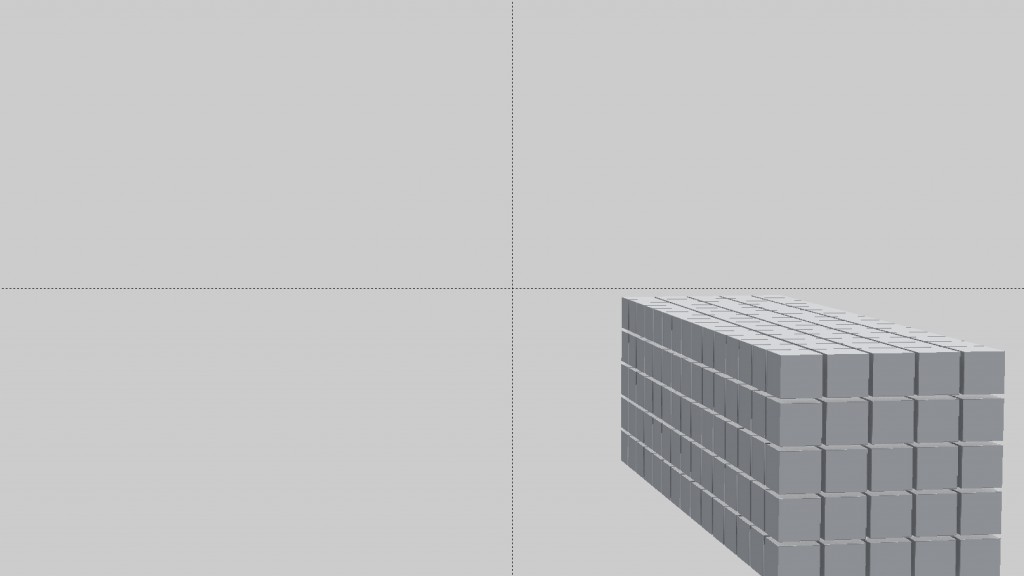
Exemplary ways to deal with that problem are as follows:
- erasing unnecessary divisions,
- extending an element deeper into the screen,
- increasing spaces between divisions,
- merging few divisions into one shape.
3.2. Mockup animation
Generally weapon in a frame stays still. Sometimes, however, there are moments where animation is necessary (e.g. reloading weapon).
At the stage of whitebox object creation it is worth to create a simple animation (mockup). The mockup of animation doesn’t have to be polished. Its only function is to check which parts of the weapon will be visible in the FPP view during the animation. It also tells us which movable parts of weapon will be visible and to what extent.
3.1. An object look in the FPP
The FPP perspective is very limiting. In a frame only a part of weapon is visible, and this part is the most important for a graphic. All elements should be given the right proportions and arrangement so that the cropped picture would show more than is really visible. All the uniqueness of a weapon must be expressed in this visible part. Therefore, while working on a silhouette it’s worth checking if what we can see in the FPP perspective applies to the features of the whole object.
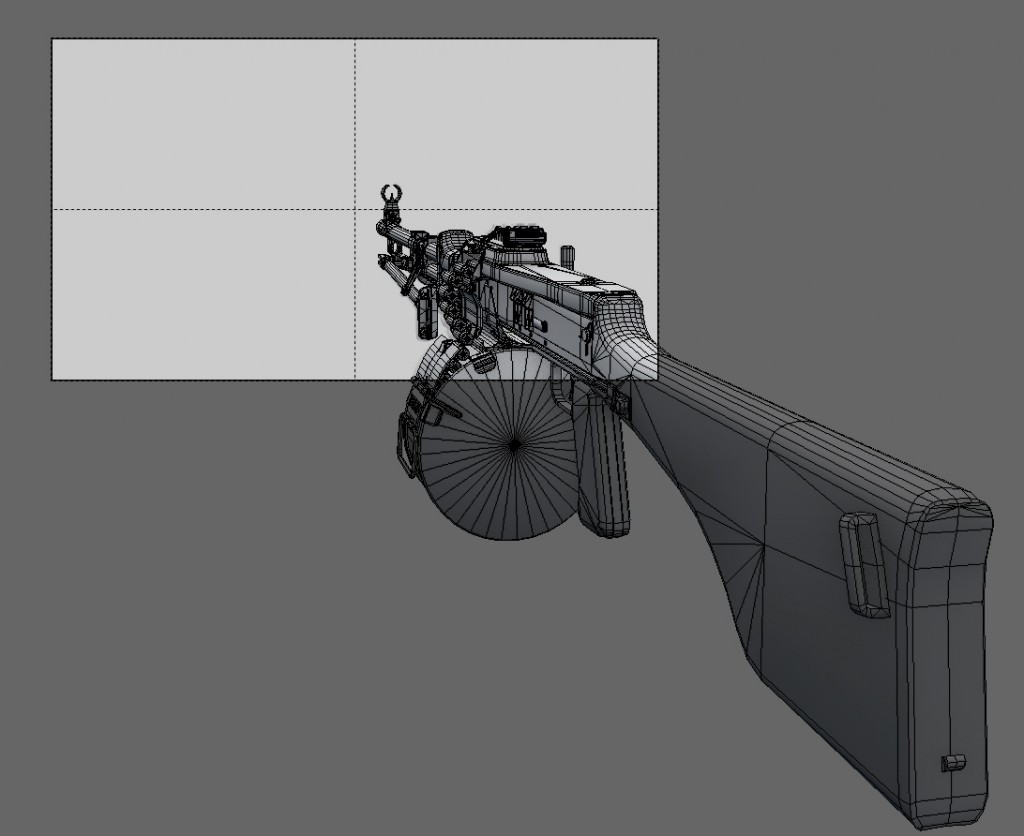
When a prop is placed statically, on the right side of the screen, its left side is far more important. Such assumption causes that some parts of the object are mirrored to make it more attractive in the frame.
![Yaron Levi. <b>MSBS Call of Duty: Ghosts</b> [portfolio online]. 2013, <i>source: http://yaron-levi.squarespace.com/call-of-duty-ghosts/</i>](http://piratportfolio.com/fpp_eng/wp-content/uploads/2015/08/3.1.A.II_.jpg)
![Ubisoft Montreal. <b>Far Cry 4</b> [PS4]. Ubisoft, 2014, <i>source: http://www.imfdb.org/wiki/Far_Cry_4#FN_Minimi</i>](http://piratportfolio.com/fpp_eng/wp-content/uploads/2015/08/FC4-MKG-71-1024x576.jpg)
- crossing the geometry of different attachments,
- incorrect scale of attachments,
- incoherent width of fixing devices (e.g. a rail),
- maladjustment caused by mutual exclusion of attachments, e.g. lack of possibility to attach a torch and a grenade launcher together.
An example of the extensive system of weapon customization. In this case all the parts had to be well thought and adjusted at the stage of whitebox creation.
3.0. The beginning of modelling
You can’t disagree with an opinion that games are part of the pop culture. It reaches wide range of people who are not very much into arts. Laymen eagerly express their opinions about the visual part – after all we are talking about video games. Unfortunately, the lack of specialized knowledge results in judging games on the basis of textures resolution, level of details, frames per second, etc. It’s like judging a painting on the basis of the size of its canvas.
It is the object that matters for a graphic, as it is seen as the first one. Of course, we cannot forget about details altogether. They can, however, be dealt with on further stage of work. It is the solid that should determine details, not the other way round.
The first stage in working on an object is to create a very simple object, made up of very trivial shapes. Such an object is called whitebox. Thanks to the basic cubature all necessary alternations and changes can be easily implemented.
The issues that should be determined at this stage are above all:
- the size of weapon,
- the dimensions and proportions of the main elements,
- the number and position of each attachment,
- movable elements.
Correctly prepared whitebox makes the work much easier and faster. Although it will never be used in a game, it serves as a determinant of the basic parameters in the process of an object creation.
3. Silhouette and whitebox
2.4. The character of each model
Each weapon has its unique character and features that need to be highlighted, also in the frame. Sometimes the weapon itself determines the set-up which is most favorable for a particular model.
For example:
This rifle has a great detail at the magazine. It would be worth capturing it in the camera view.
![Ubisoft Montreal. <b>Far Cry 3</b> [PC]. Ubisoft, 2012, <i>source: http://www.imfdb.org/wiki/Far_Cry_3 </i>](http://piratportfolio.com/fpp_eng/wp-content/uploads/2015/07/2.4.A_I-1024x576.jpg)
![id Software. DOOM [materiały promocyjne]. Bethesda Softworks, 2015, źródło: http://www.dsogaming.com/screenshot-news/doom-new-quakecon-2015-screenshots-released/](http://piratportfolio.com/fpp_eng/wp-content/uploads/2015/08/3.7.A_VIII-1024x576.jpg)
![id Software. DOOM [materiały promocyjne]. Bethesda Softworks, 2015, źródło: http://wccftech.com/doom-4k-screenshots-absolutely-breathtaking/](http://piratportfolio.com/fpp_eng/wp-content/uploads/2015/08/3.7.A_VII-1024x625.jpg)
![Harry C. Mossy stream [online]. source: http://oureverydayadventures.com/?p=1108](http://piratportfolio.com/fpp_eng/wp-content/uploads/2015/08/3.7.A_VI-1024x680.jpg)
![Pierre Leclerc. Jumbo Rocks In Joshua Tree National Park [online]. source: http://fineartamerica.com/featured/jumbo-rocks-in-joshua-tree-national-park-pierre-leclerc.html](http://piratportfolio.com/fpp_eng/wp-content/uploads/2015/08/3.7.A_V.jpg)
![Kurt Schwitters. Merz. 1931. [online], source: http://blog.naver.com/PostView.nhn?blogId=dongsungbang&logNo=220511691813&redirect=Dlog&widgetTypeCall=true](http://piratportfolio.com/fpp_eng/wp-content/uploads/2015/08/3.7.A_IV-1024x754.jpg)
![Wojtek Starak. Plaster paint worn [online]. source: http://www.textures.com/download/plasterpaintworn0047/65181](http://piratportfolio.com/fpp_eng/wp-content/uploads/2015/08/3.7.A_I-1024x693.jpg)
![Kurt Schwitters. Merz. 1931. [online], source: https://www.flickr.com/photos/32357038@N08/3254196713](http://piratportfolio.com/fpp_eng/wp-content/uploads/2015/08/3.7.A_III.jpg)
![Tomasz Przechlewski. Amarillaria mushroom fruiting bodies on tree trunk [online]. source: http://gardendrum.com/2012/11/18/ornamental-tree-diseases-in-sydney/](http://piratportfolio.com/fpp_eng/wp-content/uploads/2015/08/3.7.A_II-768x1024.jpeg)
![MachineGames. Wolfenstein: The New Order [PC]. Bethesda Softworks, 2014](http://piratportfolio.com/fpp_eng/wp-content/uploads/2015/08/3.6.A.II_-350x197.jpg)
![WE Luger P08 [online]. source: http://airsoftoperator.com/review-luger-p08-4/](http://piratportfolio.com/fpp_eng/wp-content/uploads/2015/08/3.6.A.V-350x233.jpg)
![Irrational Games. BioShock Infinite [PC]. 2K Games, 2013,](http://piratportfolio.com/fpp_eng/wp-content/uploads/2015/08/3.6.A.I-350x197.jpg)
![Pistolet Mauser Model C96 [online]. źródło: https://pl.wikipedia.org/wiki/Mauser-Werke_Oberndorf_Waffensysteme_GmbH](http://piratportfolio.com/fpp_eng/wp-content/uploads/2015/08/3.6.A.IV_-350x190.jpg)
![MachineGames. Wolfenstein: The New Order [PC]. Bethesda Softworks, 2014](http://piratportfolio.com/fpp_eng/wp-content/uploads/2015/08/3.6.A.III_-350x197.jpg)
![Smith & Wesson Bodyguard model 49 [online]. źródło: https://en.wikipedia.org/wiki/Smith_%26_Wesson_Bodyguard](http://piratportfolio.com/fpp_eng/wp-content/uploads/2015/08/3.5.B.II_-350x249.jpg)
![Smith & Wesson model 686 [online]. źródło: https://en.wikipedia.org/wiki/Smith_%26_Wesson_Model_686](http://piratportfolio.com/fpp_eng/wp-content/uploads/2015/08/3.5.B.V-350x250.jpg)
![Smith & Wesson model Model 25-5 DA [online]. źródło: http://www.icollector.com/Smith-Wesson-Model-25-5-DA-revolver-45-Colt-cal-6-barrel-blue-finish-checkered-medallion_i11015638](http://piratportfolio.com/fpp_eng/wp-content/uploads/2015/08/3.5.B.I-350x201.jpg)
![Colt SAA [online]. źródło: http://www.engravingtransfers.com/les_schowe_colt_45_saa_3.html](http://piratportfolio.com/fpp_eng/wp-content/uploads/2015/08/3.5.B.III_-350x140.jpg)
![Infinity Ward, Sledgehammer Games. Call of Duty: Modern Warfare 3 [PC]. Activision, 2011, source: http://www.imfdb.org/wiki/Modern_Warfare_3](http://piratportfolio.com/fpp_eng/wp-content/uploads/2015/08/3.4.A.V-350x197.jpg)
![Infinity Ward, Sledgehammer Games. Call of Duty: Modern Warfare 3 [PC]. Activision, 2011, source: http://www.imfdb.org/wiki/Modern_Warfare_3](http://piratportfolio.com/fpp_eng/wp-content/uploads/2015/08/3.4.A.VI_-350x197.jpg)
![3Point Studios. Brink weapons [online portfolio]. 2011, source: http://www.3pointstudios.com/portfolio_weapons.shtml](http://piratportfolio.com/fpp_eng/wp-content/uploads/2015/08/3.4.A.IV_-350x197.jpg)
![3Point Studios. Brink weapons [online portfolio]. 2011, source: http://www.3pointstudios.com/portfolio_weapons.shtml](http://piratportfolio.com/fpp_eng/wp-content/uploads/2015/08/3.4.A.I-350x197.jpg)
![3Point Studios. Brink weapons [online portfolio]. 2011, source: http://www.3pointstudios.com/portfolio_weapons.shtml](http://piratportfolio.com/fpp_eng/wp-content/uploads/2015/08/3.4.A.II_-350x197.jpg)
![3Point Studios. Brink weapons [online portfolio]. 2011, source: http://www.3pointstudios.com/portfolio_weapons.shtml](http://piratportfolio.com/fpp_eng/wp-content/uploads/2015/08/3.4.A.III_-350x197.jpg)
